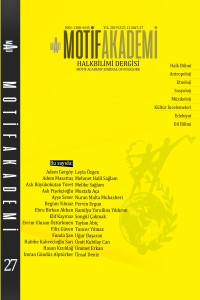Öz
Chests,
which have had a significant place in the daily lives of people in several
cultures from the past to the present, do not lose their main structural
function although they have contained unique contents in all periods and
cultural settings. This study provides brief information about the place of
chests in fold culture from the past to the present and explains the functional
characteristics of chests in the case of Tatar and Bashkir stories.
Several
common features may be observed in the creativity of Tatar and Bashkir artists
who deal with the topic of standing against corruption today by preserving the
culture of the past and attribute a significant meaning to the image of chests
in this process. In literary works, a chest is presented as a word that carries
elements of the national culture, a code of a certain culture. The author is
concerned with the protective function of a chest and its contents that reflect
the traces the national culture, rather than its form. A chest is a microworld
that collects national and religious traditions in it and protects them, a box
of memory that harbors the most beautiful hopes and valuable memories of the
main character; a chest that is assumed to be tangible is, for the elderly, is
a living object that is a witness of the past and their abstract thoughts,
spiritual values.
Antiquated,
worn out chests are the most valuable thing that supports the continuation of
the past ear in the conditions of the new era for every elderly person. Except
for the tale of “master and apprentice”, authors see grandmothers as those who
preserve culture and national values and transfer these to future generations
and describe them on the level of a symbol as the Mothers of the Nation. Such
works that reflect folk culture are also a rich source for studies in the field
of ethnolinguistics.
Anahtar Kelimeler
Kaynakça
- Biyişeva, Zeynep ( 2005). Usta ve Çırak / Türkiye Dışındaki Türk Edebiyatları Antolojisi, 30 Cilt. Başkurt Edebiyatı. Ankara :T.C. Kültür Bakanlığı Yayınları, 346-359. Latıyfi, Flüs, Gümüş Bilezik/ Türkiye Dışındaki Türk Edebiyatları Antolojisi (2001), 19 Cilt. Tatar Edebiyatı, Ankara:T.C.Kültür Bakanlığı Yayınları, 409-419 .Hayretdinova, Aida, Kaderin Dersi / Söylemez O, Azap Samet (2016). Türk Dünyası Edebiyatları, Hikâye Çözümlemeleri. İstanbul:Kesit Yayınları, 309-314.Yeniki, Emirhan (2012). Vasiyet /Vasiyet, (Çev.: Fatih Kutlu, Hamza Ersoy, Nadir T.Arslan), İstanbul:Zambak Yayınları, 54-101.
Öz
En
eski dönemlerden bugüne kadar pek çok kültürde halkın günlük yaşamında önemli
yer tutan sandıklar, her dönemde ve kültürel ortamda kendine özgü içerik
almasına rağmen, yapısal olarak ana vazifesini kaybetmez. Çalışmada geçmişten
günümüze kadar sandığın halk kültüründeki yeri hakkında kısaca bilgilendirilir;
Çağdaş Tatar ve Başkurt hikâyeleri örneğinde betimleme, yorum ve mukayese
yöntemleri aracıyla sandığın fonksiyonel özelliği açıklanır.
Geleneksel
kültürü koruyarak, günümüzdeki yozlaşmaya karşı durabilme konusunu ele alan ve
bu süreçte sandık imajına önemli anlam yükleyen komşu sanatçıların
yaratıcılığında pek çok ortak özellik göze çarpar. Edebi eserlerde sandık, milli kültür
öğelerini taşıyan sözcük, belli bir kültürün kodu olarak sunulur. Yazarı sandığın
biçiminden ziyade, onun koruyucu özelliği, milli kültürün izlerini yansıtan
içeriği ilgilendirir. Bir taraftan sandık, milli ve dini gelenekleri içine
toplayan, onları koruyan bir mikro dünya; diğer taraftan ana kahramanın
gençliğinin en güzel umutlarını ve değerli hatıralarını kendisinde barındıran
bir hatıra kutusudur. Aynı zamanda somut gibi kabul edilen sandık, yaşlılar
için geçmişin ve soyut düşüncelerinin, manevi değerlerinin şahidi olan canlı
bir nesnedir.
Eskimiş,
yıpranmış sandıklar her yaşlı için geçmiş dönemin yeni zaman koşullarında da
devam edebilmesine destek olan en değerli eşyadır. “Usta ve Çırak” hikâyesi hariç, yazarlar
kültürü ve milli değerleri koruyan ve gelecek kuşağa aktaranlar olarak nineleri
görür, onları Milletin Anası olarak simge seviyesinde tasvir ederler. Halk kültürünü
yansıtan bu tür eserler kültürdilbilim açısından incelemeler için de zengin
kaynak içerir.
Anahtar Kelimeler
Kaynakça
- Biyişeva, Zeynep ( 2005). Usta ve Çırak / Türkiye Dışındaki Türk Edebiyatları Antolojisi, 30 Cilt. Başkurt Edebiyatı. Ankara :T.C. Kültür Bakanlığı Yayınları, 346-359. Latıyfi, Flüs, Gümüş Bilezik/ Türkiye Dışındaki Türk Edebiyatları Antolojisi (2001), 19 Cilt. Tatar Edebiyatı, Ankara:T.C.Kültür Bakanlığı Yayınları, 409-419 .Hayretdinova, Aida, Kaderin Dersi / Söylemez O, Azap Samet (2016). Türk Dünyası Edebiyatları, Hikâye Çözümlemeleri. İstanbul:Kesit Yayınları, 309-314.Yeniki, Emirhan (2012). Vasiyet /Vasiyet, (Çev.: Fatih Kutlu, Hamza Ersoy, Nadir T.Arslan), İstanbul:Zambak Yayınları, 54-101.
Ayrıntılar
| Birincil Dil | Türkçe |
|---|---|
| Konular | Sanat ve Edebiyat |
| Bölüm | Makaleler |
| Yazarlar | |
| Yayımlanma Tarihi | 20 Eylül 2019 |
| Gönderilme Tarihi | 8 Temmuz 2019 |
| Yayımlandığı Sayı | Yıl 2019 Cilt: 12 Sayı: 27 |



